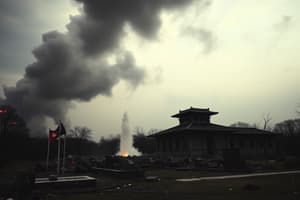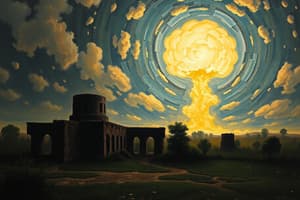Podcast
Questions and Answers
What symptom did Dr. Sasaki notice on Miss Sasaki's skin?
What symptom did Dr. Sasaki notice on Miss Sasaki's skin?
- Hemorrhages (correct)
- Blistering
- Bruises
- Rash
Who among the characters falls ill after walking through the city to deposit money?
Who among the characters falls ill after walking through the city to deposit money?
- Mr. Tanimoto
- Mrs. Nakamura
- Father Kleinsorge (correct)
- Miss Sasaki
What happened to Dr. Fujii's clinic after the heavy rains and floods in early September?
What happened to Dr. Fujii's clinic after the heavy rains and floods in early September?
- It was evacuated as a precaution
- It was moved to a new location
- It remained intact
- It was destroyed by the flood (correct)
Who becomes a curiosity in Tokyo after recovering from radiation sickness?
Who becomes a curiosity in Tokyo after recovering from radiation sickness?
What does Mrs. Nakamura do after her hair has grown back?
What does Mrs. Nakamura do after her hair has grown back?
What was Father Kleinsorge's condition when he returned to Hiroshima after the radiation level was deemed safe?
What was Father Kleinsorge's condition when he returned to Hiroshima after the radiation level was deemed safe?
Who did Father Kleinsorge visit in the hospital, resulting in her eventual conversion to Catholicism?
Who did Father Kleinsorge visit in the hospital, resulting in her eventual conversion to Catholicism?
What did Dr. Sasaki analyze along with fellow doctors?
What did Dr. Sasaki analyze along with fellow doctors?
What is the current state of Mr. Tanimoto's church?
What is the current state of Mr. Tanimoto's church?
What is Mrs. Nakamura's current financial situation?
What is Mrs. Nakamura's current financial situation?
What did the new municipal government plan to do to rebuild the city?
What did the new municipal government plan to do to rebuild the city?
What do the people of Hiroshima think about the ethical implications of the bombing?
What do the people of Hiroshima think about the ethical implications of the bombing?
What is the main focus of the chapter 'Panic Grass and Feverfew' in the book 'Hiroshima' by John Hersey?
What is the main focus of the chapter 'Panic Grass and Feverfew' in the book 'Hiroshima' by John Hersey?
What is the Planning Conference mentioned in the chapter?
What is the Planning Conference mentioned in the chapter?
What is the significance of the ash piles and stationary cars and bicycles on the street in Hiroshima?
What is the significance of the ash piles and stationary cars and bicycles on the street in Hiroshima?
What is the three-stage theory of radiation sickness proposed by Dr. Sasaki and his fellow physicians?
What is the three-stage theory of radiation sickness proposed by Dr. Sasaki and his fellow physicians?
What is the purpose of the medical establishment and statisticians in the aftermath of the bombing?
What is the purpose of the medical establishment and statisticians in the aftermath of the bombing?
What is the author's style in describing the events in the chapter?
What is the author's style in describing the events in the chapter?
What is the main theme of the chapter 'Panic Grass and Feverfew' in the book 'Hiroshima' by John Hersey?
What is the main theme of the chapter 'Panic Grass and Feverfew' in the book 'Hiroshima' by John Hersey?
What is the name of the chapter?
What is the name of the chapter?
What is the Planning Conference?
What is the Planning Conference?
What are some of the effects of radiation sickness described in the chapter?
What are some of the effects of radiation sickness described in the chapter?
What is Dr. Sasaki's theory about radiation sickness?
What is Dr. Sasaki's theory about radiation sickness?
What is the purpose of the medical establishment and statisticians in Hiroshima after the bombing?
What is the purpose of the medical establishment and statisticians in Hiroshima after the bombing?
What is the author's style in describing the events in Hiroshima?
What is the author's style in describing the events in Hiroshima?
What is the main issue faced by survivors in the aftermath of the bombing?
What is the main issue faced by survivors in the aftermath of the bombing?
Study Notes
"Panic Grass and Feverfew" Chapter Summary
- The chapter is named after weeds growing in Hiroshima, perhaps symbolizing the survivors' desire to drive away the fever associated with radiation sickness.
- The city of Hiroshima is described through personal thoughts of survivors and objective statistics.
- Imagery evokes an understanding of the swiftness of death, such as signs on ash piles and stationary cars and bicycles on the street.
- The government must deal with practical issues like lack of electricity and clean water, and a Planning Conference is called to decide what to do with the debris.
- Hersey's factual, journalistic style produces a profound reaction in the reader without sensationalizing or dramatizing.
- The largest portion of the chapter describes the horrifying effects of radiation sickness on the six survivors, including wounds that won't heal, hair loss, diarrhea, weakness, and depression.
- Lack of medical supplies, doctors, and nurses, and medical inexperience with radiation sickness contribute to the problem.
- Survivors try to rebuild homes and churches, feed and clothe children, and come to some sort of closure with what has happened.
- Dr. Sasaki and his fellow physicians theorize that radiation survivors have three stages to their illness.
- Hersey seems to be layering page after page of quantitative terms and numerical equivalents to explain how the governmental institutions of the time treated the survivors and the city as a huge experiment in new technology.
- The medical establishment and statisticians assault the city to gather accurate and measurable statistics for the future.
- In opposition to the facts and figures, six survivors' lives symbolize the individual suffering caused but rarely measured by the bombing.
Studying That Suits You
Use AI to generate personalized quizzes and flashcards to suit your learning preferences.
Description
"Can You Survive the Fallout? Test Your Knowledge of Radiation Sickness in Hiroshima" - Take this quiz to learn about the devastating effects of radiation sickness on the survivors of the Hiroshima bombing. From Father Kleinsorge's weakened state to Mrs. Nakamura's hair loss, see if you can identify the symptoms and aftermath of exposure to radiation. Test your knowledge and learn about the tragic consequences of this historical event.




